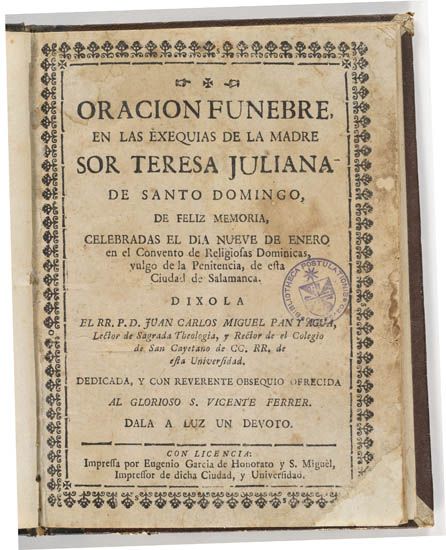Sale 2271 - Lot 510
Unsold
Estimate: $ 15,000 - $ 25,000
THE ONLY KNOWN COPY (RELIGION.) PAN Y AGUA, RR P.D. JUAN CARLOS MIGUEL. Oracion Funebre en las Exequias de la Madre Sor Teresa Juliana de Santo Domingo, de Feliz Memoria, Celebradas el dia Nueve de Enero en el Convento de Religiosas. [viii], 1-24 pp. 4to, later polished black calf-backed cloth-covered boards; early paper repair to the bottom right corner of the title-page and leaf 7-8, a few stains here and there, paper evenly toned. [Salamanca, 1749]
Additional Details
a unique copy of the funeral oracion on the death of sister teresa juliana (chicaba) de santo domingo (ca 1646-1749), an african. Born in the northeastern portion of today's Ghana, Chicaba was probably a member of the Ewe tribal group. She was taken by Spanish sailors and sold to an aristocratic family in Spain, where "she showed great piety." According to the official hagiography, written by the same author as the present funeral oration, Chicaba inherited a substantial "dowry" from her mistress, the Duchess of Arcos, Marquesa de Mancera. She took the dowry and tried to enter the order of Saint Mary in Salamanca, but because of her color, she was refused. Instead, the Holy Mother allowed her to work as a maid for the order. Some years later, the Holy Mother relented and allowed Chicaba to take her final vows, but still restricted her officially to the position of maid. Despite this, Chicaba--now sister Teresa Juliana devoted her life to the needs of the poor and sick in the community.
What we know of sister Teresa Juliana comes from father Juan Carlos Pan y Agua, who states that what he knew of Chicaba's early life came from her own "autobiographical writings," as well as her "poetry,"-of which sadly no copies are known to have survived. Chicaba said that she came from the region of "La Mina Baja del Oro," or the part of West Africa that extends through present day Eastern Ghana, Togo, Benin and Western Nigeria. She said she was captured when she was nine years old, and though she could remember little of her early childhood, she did remember the names of her mother and sisters, which suggest her tribal group as Ewe. She was sold to Juliana Teresa Portocarrero y Meneses, the Duchess of Arcos and third wife of the Marques de Mancera, viceroy of Mexico and protector of Sor Juana Ines de la Cruz. As a member of this household, the young Chicaba habituated herself to the piousness of her mistress and developed an intense spiritual life that in time became her key to freedom. However, according to Pan y Agua's biography, Chicaba received vicious beatings and abuse by other members of the household staff, and especially the housekeeper. In accordance to the behest of her mistress who died in 1703, Chicaba was free to join the Dominican convent of La Penitencia in Salamanca. According to Pan y Agua, Sor Teresa Juliana gained recognition as a "healer with prodigious religious gifts. In spite of her inferior status in the order, her acts of charity, her mystical experiences, and her fame as a healer and miracle worker moved her order soon after her death to commission two portraits of her for purposes of local veneration," At the same time, they began the process of her beatification, for which father Pan y Agua first wrote the present Funeral Oration, and later the full-length hagiography, cited above (Salamanca, 1752; second edition in 1764). There is no copy known other than the present of the Oracion Funebre. Of Pan y Agua's larger "Compendio de la Vida de Sor Teresa Juliana de Santo Domingo," only a single copy is located at the National Library in Madrid.
What we know of sister Teresa Juliana comes from father Juan Carlos Pan y Agua, who states that what he knew of Chicaba's early life came from her own "autobiographical writings," as well as her "poetry,"-of which sadly no copies are known to have survived. Chicaba said that she came from the region of "La Mina Baja del Oro," or the part of West Africa that extends through present day Eastern Ghana, Togo, Benin and Western Nigeria. She said she was captured when she was nine years old, and though she could remember little of her early childhood, she did remember the names of her mother and sisters, which suggest her tribal group as Ewe. She was sold to Juliana Teresa Portocarrero y Meneses, the Duchess of Arcos and third wife of the Marques de Mancera, viceroy of Mexico and protector of Sor Juana Ines de la Cruz. As a member of this household, the young Chicaba habituated herself to the piousness of her mistress and developed an intense spiritual life that in time became her key to freedom. However, according to Pan y Agua's biography, Chicaba received vicious beatings and abuse by other members of the household staff, and especially the housekeeper. In accordance to the behest of her mistress who died in 1703, Chicaba was free to join the Dominican convent of La Penitencia in Salamanca. According to Pan y Agua, Sor Teresa Juliana gained recognition as a "healer with prodigious religious gifts. In spite of her inferior status in the order, her acts of charity, her mystical experiences, and her fame as a healer and miracle worker moved her order soon after her death to commission two portraits of her for purposes of local veneration," At the same time, they began the process of her beatification, for which father Pan y Agua first wrote the present Funeral Oration, and later the full-length hagiography, cited above (Salamanca, 1752; second edition in 1764). There is no copy known other than the present of the Oracion Funebre. Of Pan y Agua's larger "Compendio de la Vida de Sor Teresa Juliana de Santo Domingo," only a single copy is located at the National Library in Madrid.

Exhibition Hours
Exhibition Hours
Aliquam vulputate ornare congue. Vestibulum maximus, libero in placerat faucibus, risus nisl molestie massa, ut maximus metus lectus vel lorem.


